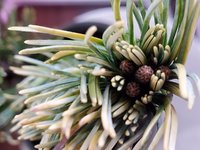electronfusion
Yamadori
I bought this young pinus parviflora 'fukai' (dwarf variegated variety) from an online nursery and was surprised to see such a high, pronounced graft, and with the only foliage so high above the graft. I have airlayered many deciduous trees with success, but never grafted. I've read lots of how-to articles on grafting, and would be willing to buy a grafting knife if I really need to, but is there any other way to make this into an aesthetically pleasing tree? I read that pine airlayers are a slow, multi-year process, and that large ones don't often survive after airlayering due to rot. So, if this tree can only be compacted by grafting, which parts would you graft, and to what? Would it be possible to graft the entire existing foliage mass onto a new jbp rootstock? Should I only use this as a source of several smaller branches for grafting onto new rootstocks? If I trim one branch off and try grafting it close to the soil line on its existing rootstock, will that hurt the rest of the foliage mass?





